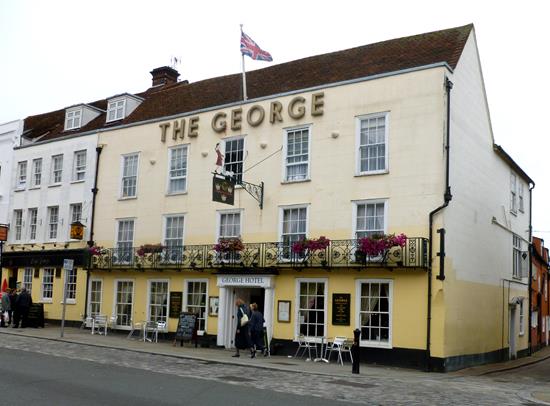Colchester is home to numerous late medieval buildings which remind us that the town flourished during this period.
The Rose and Crown Hotel on East Street is thought to be Colchester's oldest surviving timber-framed building, dating from the late 13th or early 14th century. Another of Colchester's oldest buildings is Nos 7-9 Queen Street, which is though to date from the late 14th century.
 One of the most well-known medieval buildings in the town is No. 3 West Stockwell Street, which is a 15th-century merchant's house. The Red Lion is probably the most significant late medieval building in Colchester, having been built as a town house for the Howard family, but becoming an inn by 1515. This building, along with The George Hotel and No. 118 High Street are all that survive of a number of prestigious tall buildings that once lined the High Street.
One of the most well-known medieval buildings in the town is No. 3 West Stockwell Street, which is a 15th-century merchant's house. The Red Lion is probably the most significant late medieval building in Colchester, having been built as a town house for the Howard family, but becoming an inn by 1515. This building, along with The George Hotel and No. 118 High Street are all that survive of a number of prestigious tall buildings that once lined the High Street.
The principal public building in Colchester throughout the medieval period was the elaborately decorated Moot Hall on the High Street. This building was first recorded in 1277 but was likely to have been in existence by the time of the town's first charter in 1189, and it survived until 1873, when it was demolished. In 1373 it was refurbished in order to accommodate the wool market, and it was also home to the town gaol. A bell from the moot hall which dates from around 1400 hangs in the Victoria Tower of the modern Town Hall.
The 3-bay 15th-century building now known as Nos 5-7 Stockwell also appears to have been a public building, and is described in a 17th-century deed as 'the old wool hall'.
Several of Colchester's late medieval buildings appear to have been constructed as shops, for example No. 39 East Hill, No. 93 Hythe Hill and No. 98 Hythe Hill, which may be the earliest surviving shop in the town. No. 37 Long Wyre Street, also known as Bonners, is an interesting early-15th-century jettied building which includes domestic quarters facing onto Eld Lane and shop windows and a narrow shop door on the Long Wyre Street frontage. More difficult to interpret is the complex of buildings now known as Nos 13-15 North Hill, parts of which appear to date from the early 15th century. It seems that the whole complex was intended for commercial use, and an unusual window on the ground floor suggests this part of the building was a workshop. 
The only remaining Wealden house in Colchester is Bay House on West Stockwell Street, which is likely to date from the 14th century.
In the late 12th century a grammar school was founded in the town, located on Head Street. It moved to Culver Street and was refounded by Henry VIII in 1539. Traces of the grammar school on Culver Street remained until 1956 when the last remaining parts were demolished.
Other significant late medieval buildings in the town include No. 8 Trinity Street (also known as Tymperleys) which dates from the 15th century, and was once the home of William Gilberd (1544-1603), a physician, physicist and natural philosopher who is credited with inventing the term 'electricity'. Adjacent to this is No. 7 Trinity Street which is thought to include the remains of a late 15th- or early 16th-century public building.